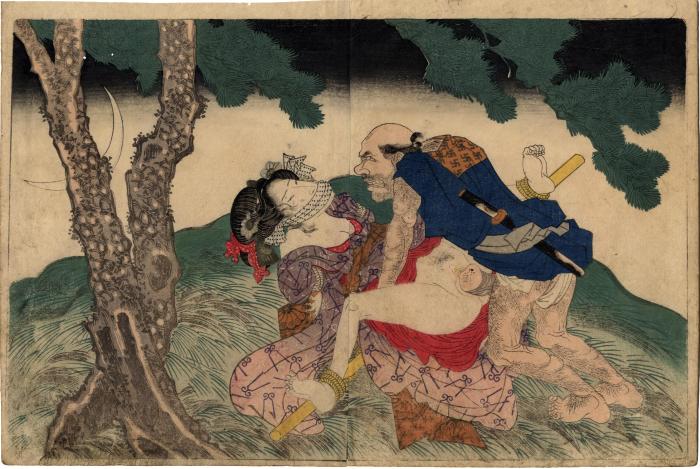Utagawa Kunisada (歌川国貞) / Toyokuni III (三代豊国) (artist 1786 – 01/12/1865)
From volume 2, Night rape In Praise of Love in the Four Seasons (Shunka shūtō, Shiki no nagame - 春夏秋冬 - 色の詠)
ca 1827 – 1829
13.75 in x 9.25 in (Overall dimensions) Japanese woodblock print
Lyon Collection - in volume 1 with images only, but no text
British Museum - the full set
The National Museum of Asian Art 'A TRULY REMARKABLE PRODUCTION, distinguished not so much for the designs, which follow a fairly predictable pattern of generally violent love scenes, portrayed with a coarseness all the more repellent on account of Kunisada's skillful realism, but for the amazing technical brilliance of the print-makers'.
Quoted from: J. Hillier The Art of the Japanese Book, London, 1987, pp.901-2.
****
In 2016 Sebastian Izzard wrote about this series of shunga prints by Kunisada and its masterful use of the new synthetic blue being imported into Japan in the late 1820s. He said:
"Twenty-seven double page openings depicting erotic scenes linked to the seasons are divided into four volumes, each of which has an illustrated frontispiece. Short racy tales by Tatekawa Enba II (1791-1862) and his circle are either integrated between the images or follow them.
The scenes are set int he countryside, on pleasure boats on the Sumida River, in geisha houses, brothels, daimyo mansions and during festivals. Great attention is paid to the interior settings and the composition of the illustration. This book employed metallic pigment highlights in its printing."
Quoted from: Kunisada: imaging, drama and beauty by Robert Schaap, 2016, p. 137. Izzard referred to this set as Kunisada's masterpiece (p. 23).
****
There is at least one volume from this set of books in the collection of the Museum of Fine Arts in Boston.
Illustrated in Fagioli Shunga Pages 141, also in Braus, Page 71.
****
Illustrated:
1) in color in 'No Laughing Matter:A Ghastly Shunga Illustration by Utagawa Toyokuni' by Higuchi Kazutaka, in Japan review : Journal of the International Research Center for Japanese Studies / SPECIAL ISSUE : Shunga: Sex and Humor in Japanese Art and Literature, 2013, figure 9, p. 253.
The author wrote on that page: "In discussing Kunisada’s Kaidan yoru no tono, Hayashi Yoshikazu noted a late Edo trend toward the depiction of scenes that deviate from the original purpose of shunga as “laughing pictures” (warai-e). For example, Kunisada’s Shiki no nagame 四季の詠, authored as one might expect by Enba, includes a cruel scene of a bandit raping a woman whose legs are bound to a pole (Figure 9). Rosina Buckland has pointed out that, in general in Shiki no nagame, the scenes of sexual activity show no sense of real emotional engagement between the male and female protagonists."
2) in color in 'Violence in Shunga by Higuchi Kazutaka in Shunga sex and pleasure in Japanese art, 2013, fig. 2, p. 381.
picture book (ehon - 絵本) (genre)
erotic prints (shunga - 春画) (genre)
